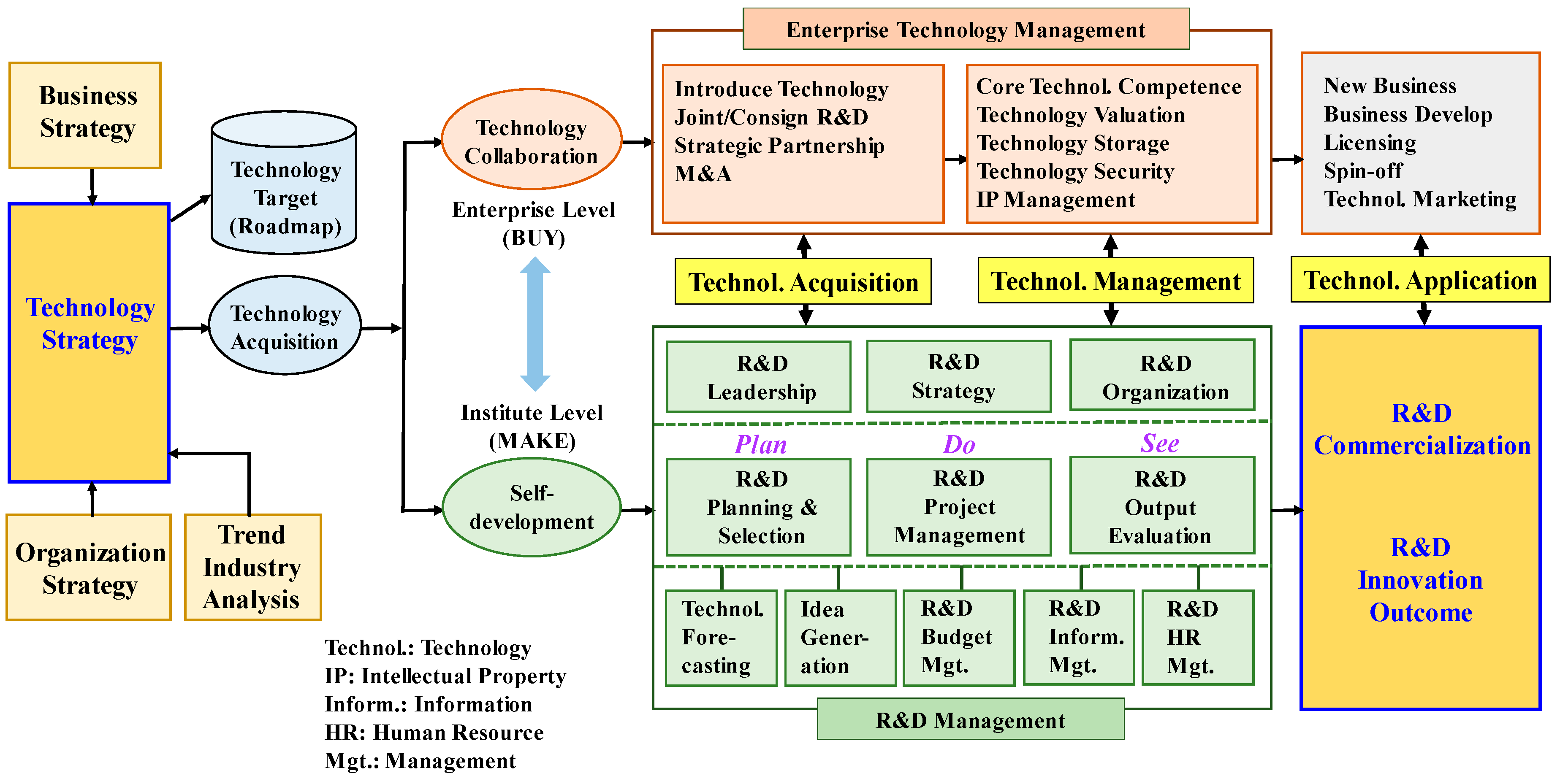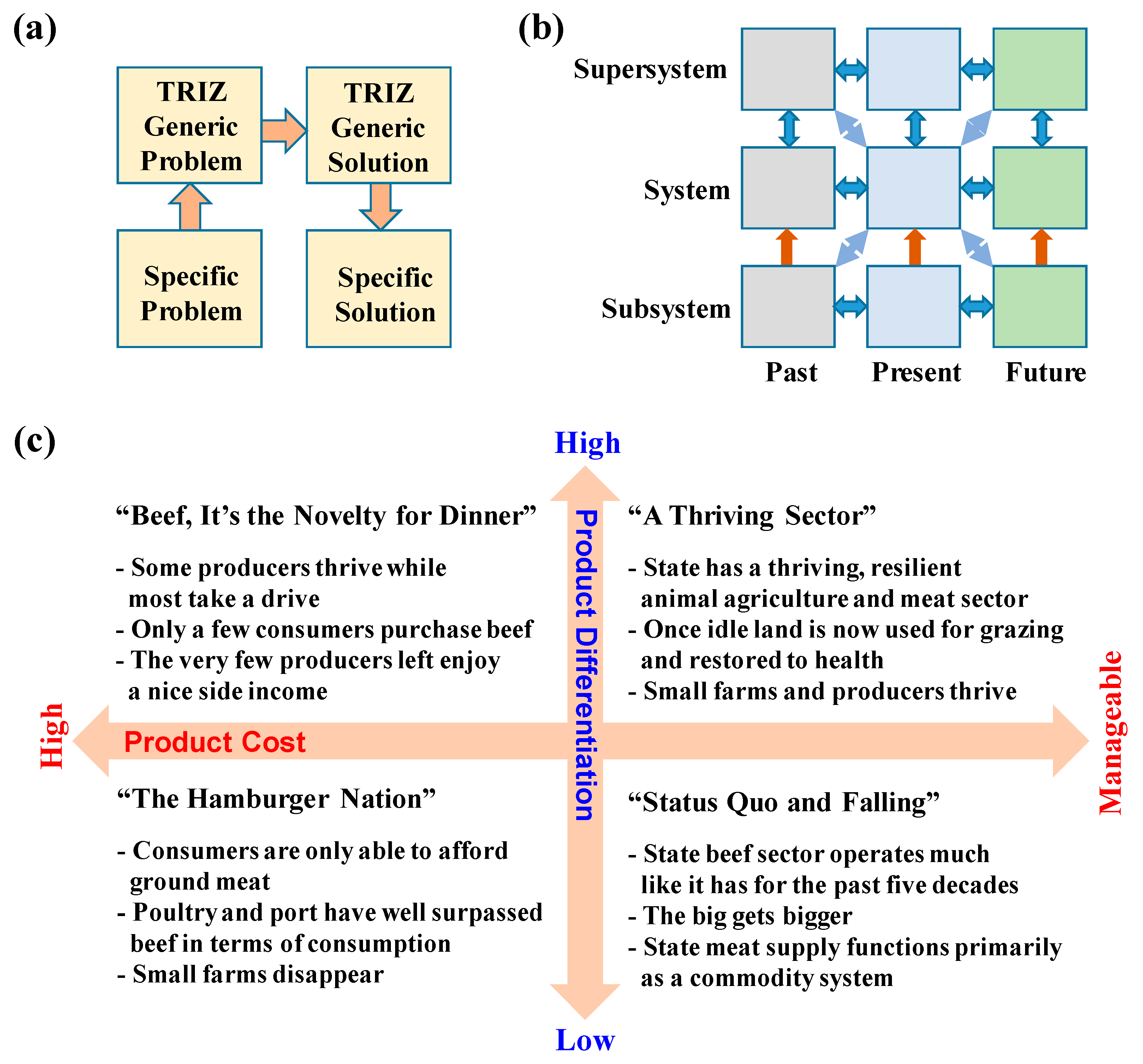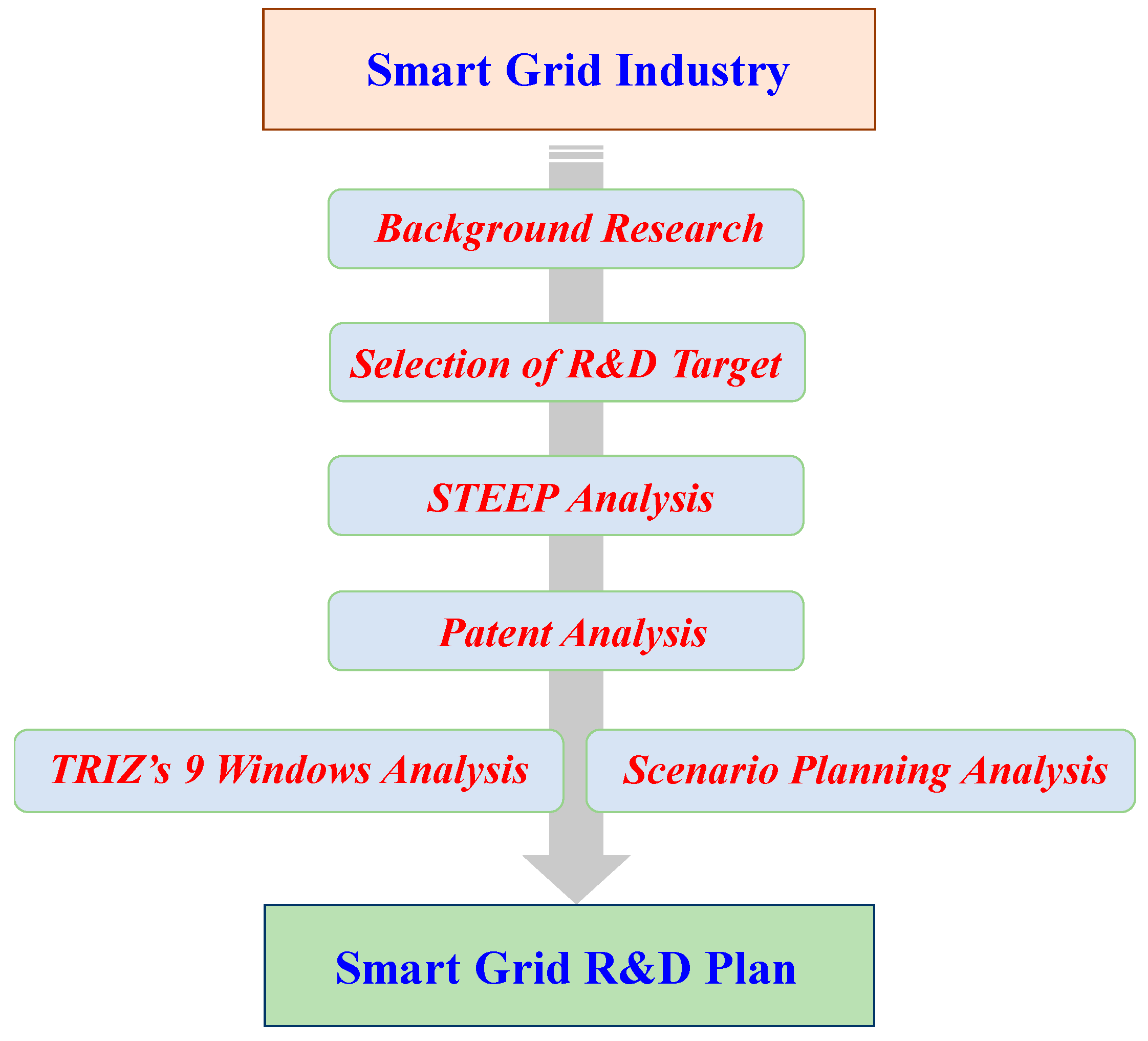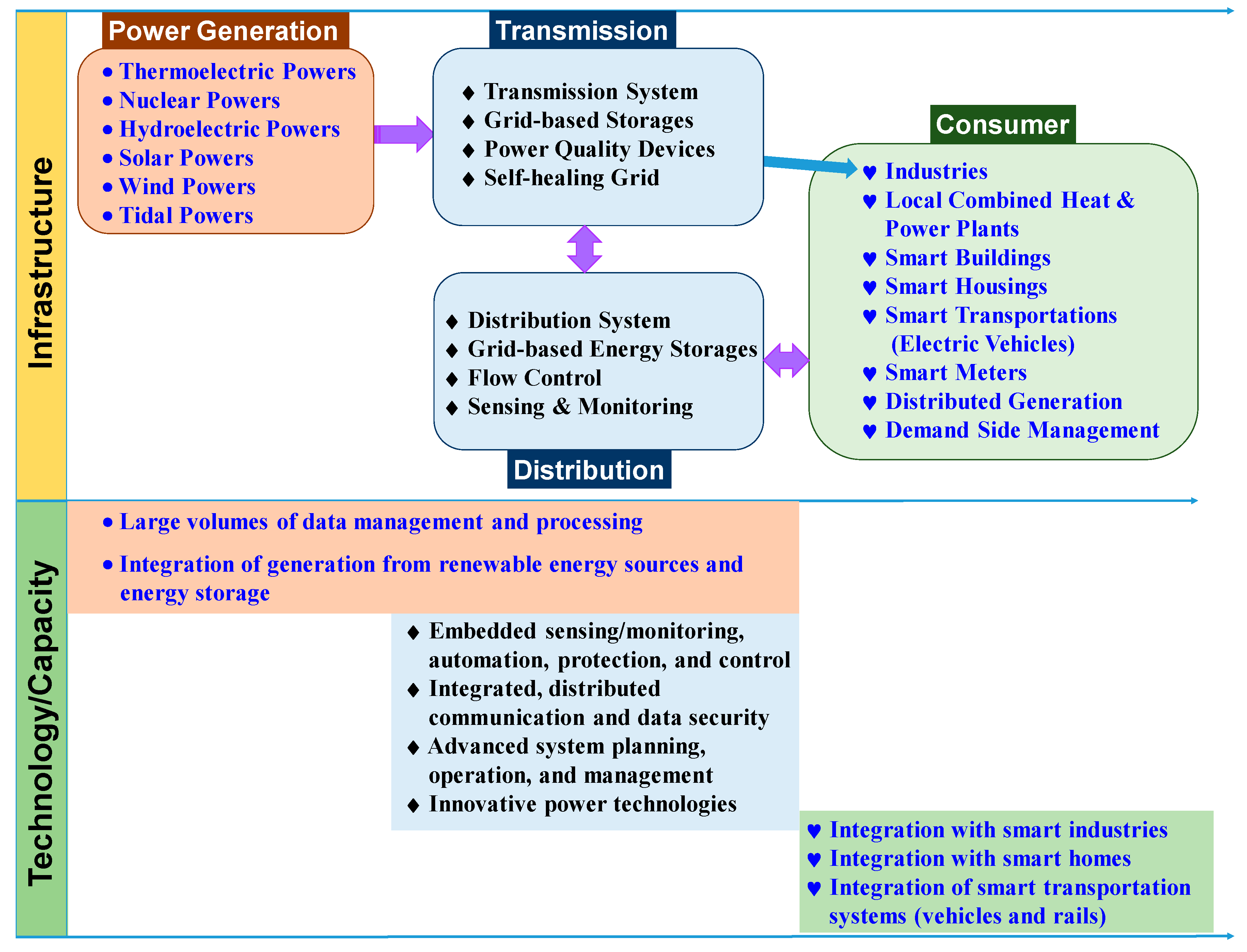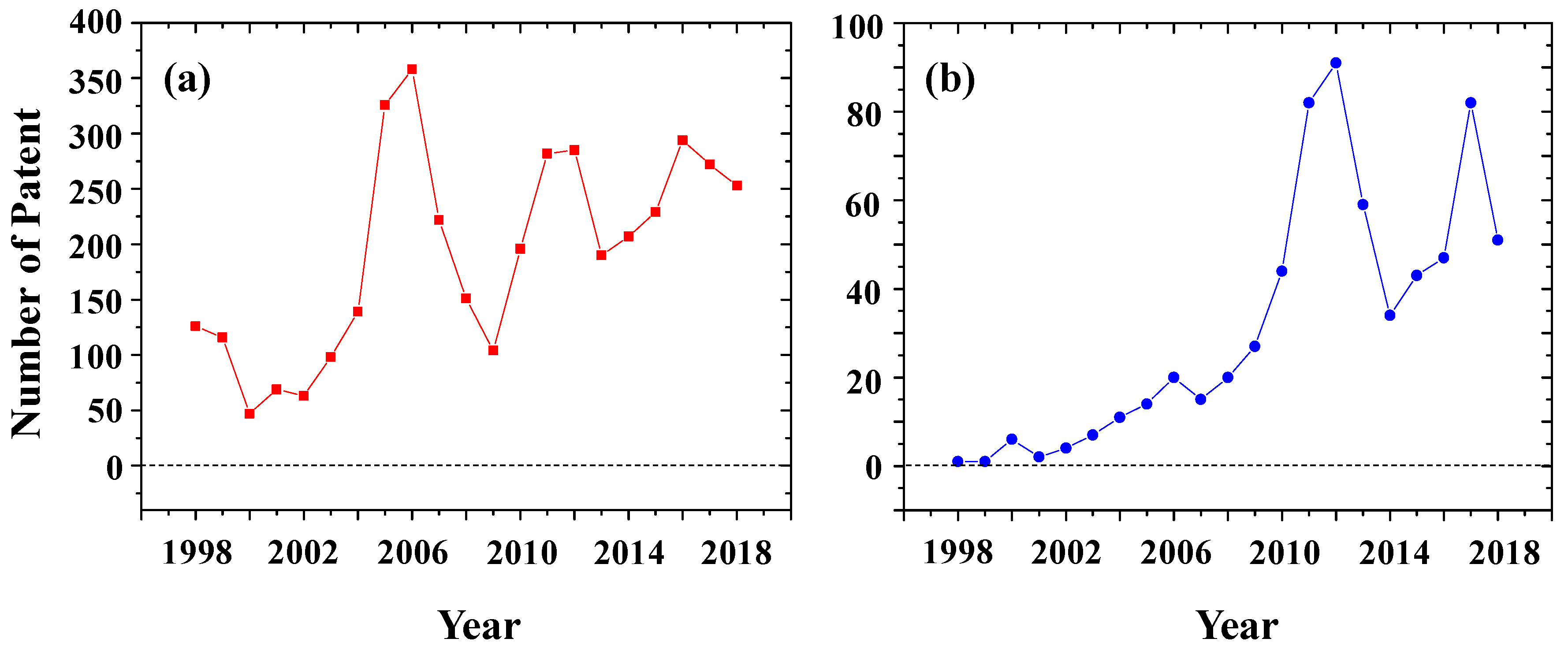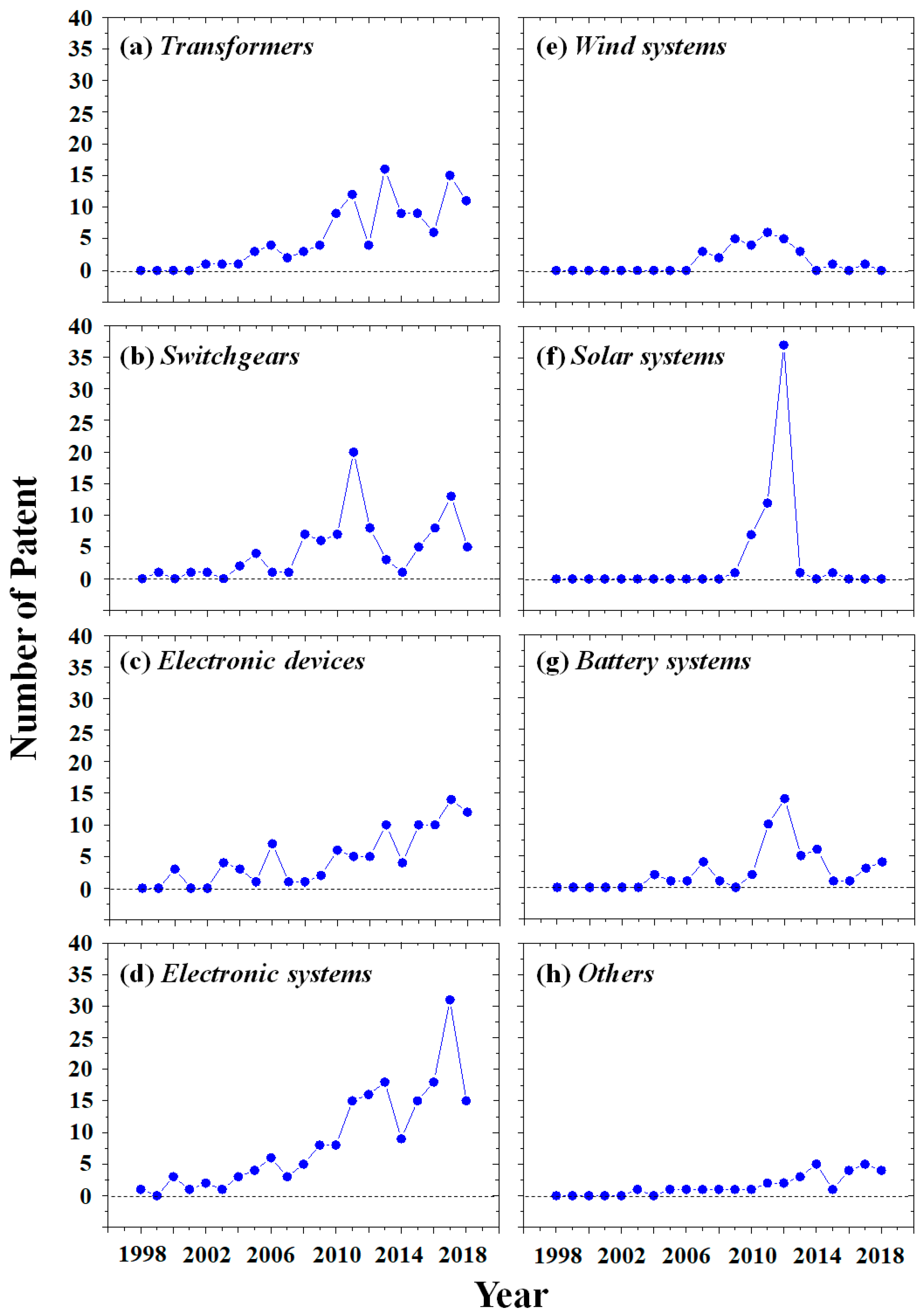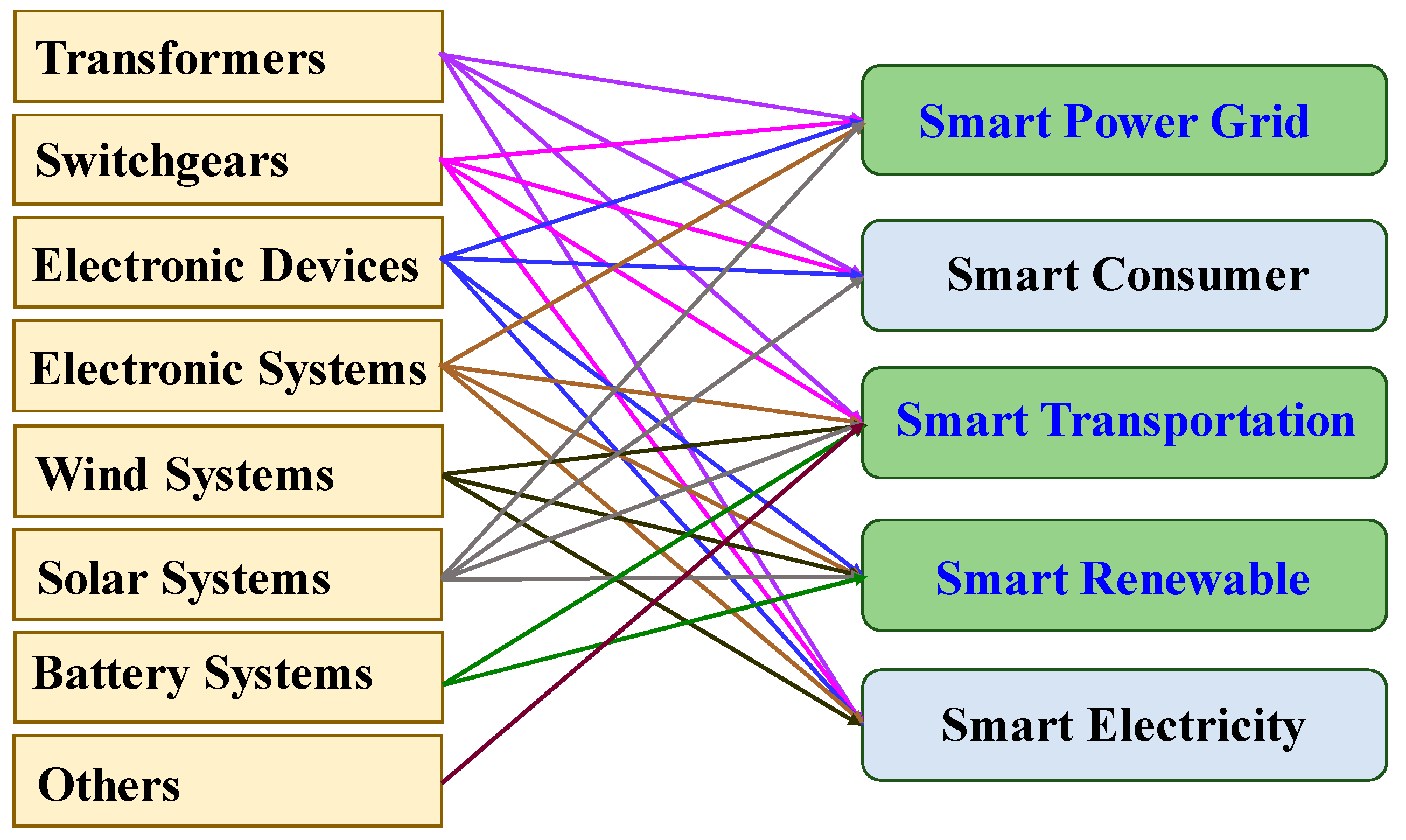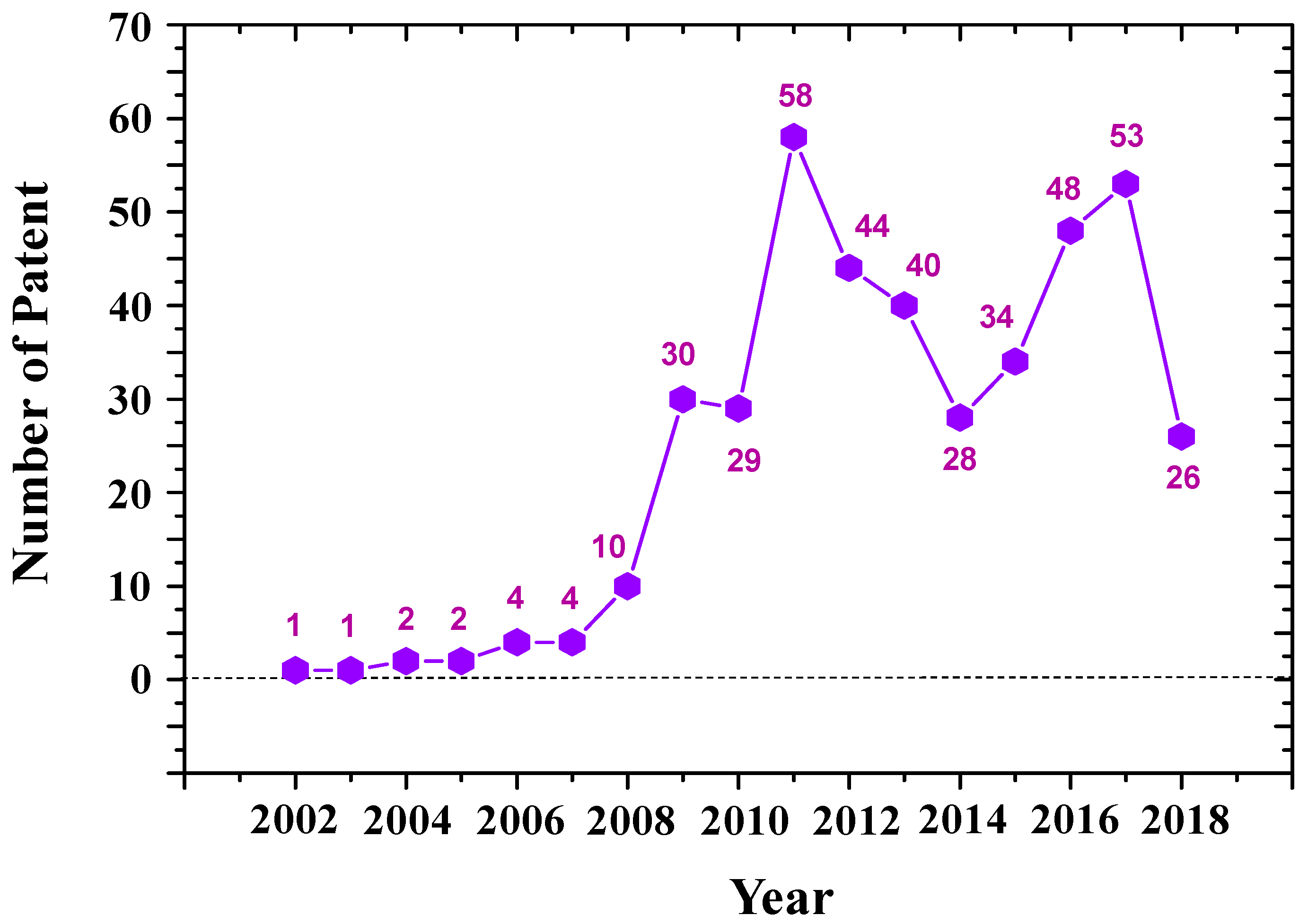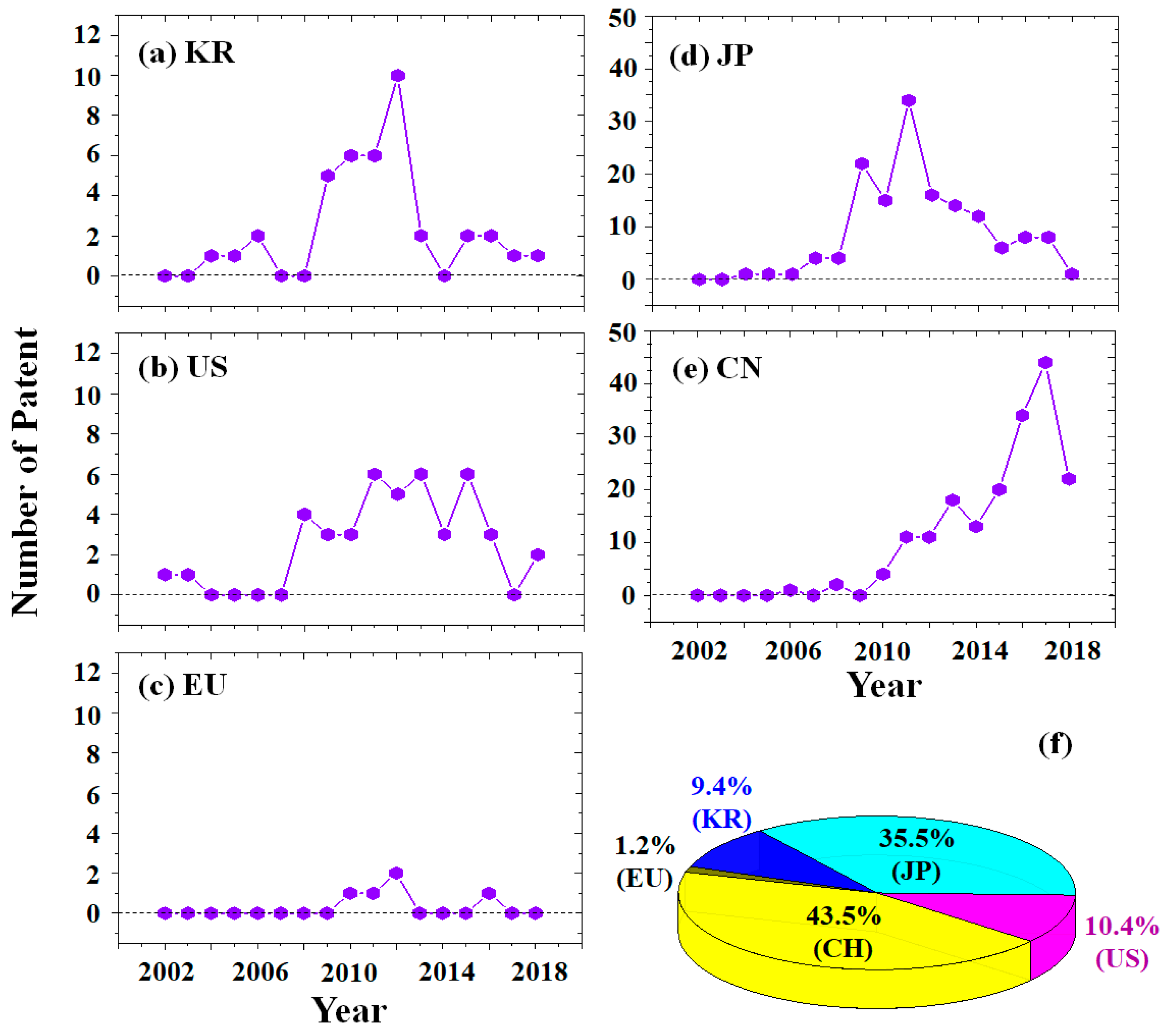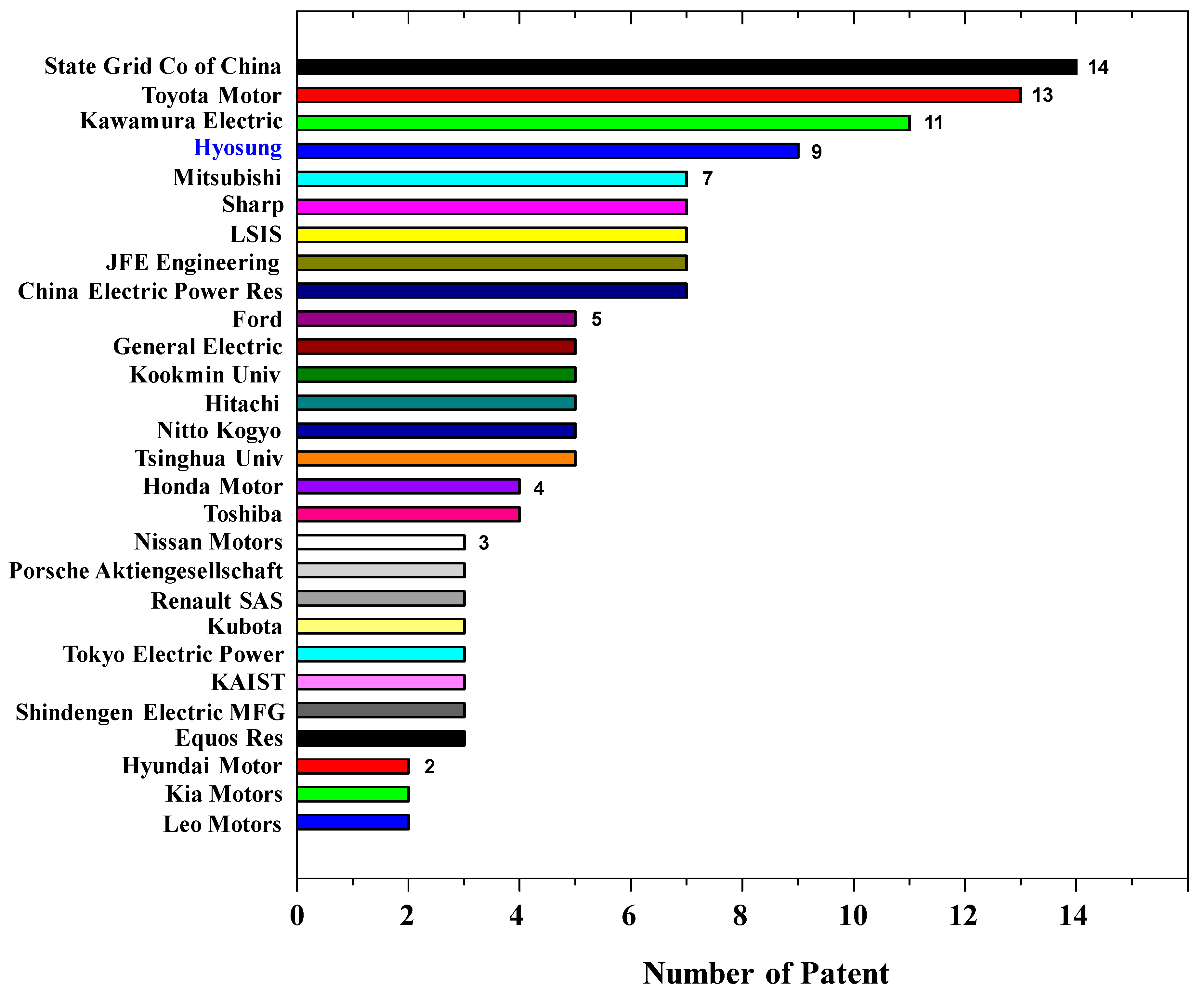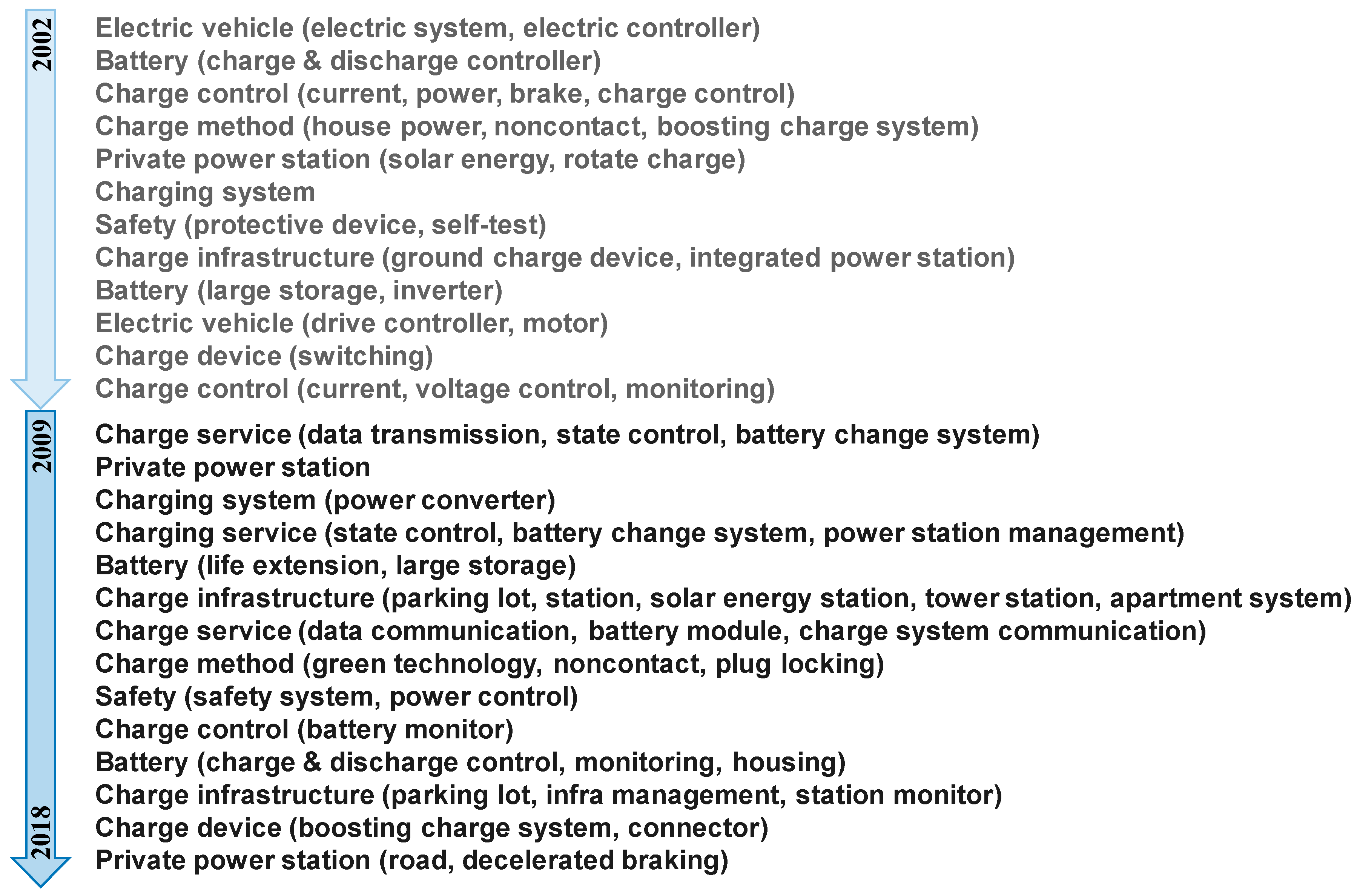This research goes beyond technological analysis by establishing a strategy from a business perspective. TRIZ’s nine windows and scenario planning methodologies have been utilized to provide a strategy from a business point of view.
4.2.1. The 9 Windows Analysis
In order to stimulate the market of electric vehicles, a consumer-friendly and convenient, not to mention efficient, electric vehicle charging system is a vital element. The electric vehicle charging system must be able to use cost-reduced power during the night and to minimize the problems faced during demand data management and demand fluctuations to properly coincide with the goals of the smart grid industry. The electric vehicle charging system has been analyzed at the current system and super-system levels in a consecutive manner to achieve these.
Figure 12 shows the analysis results. The current problem at the system level pertains to the problems with performance, implementation, and expansion of private charging stations. A 24 kWh Nissan Leaf charged into a normal Level 1 (1.4 kW) residential outlet for roughly twelve hours only recharges the battery to half capacity and would cost approximately
$60 per month; and, it costs
$1500–
$2200 for users to install a Level 2 220-volt (6.6 kW) system, which is capable of fully charging the car in seven hours [
45]. Essentially, long charging time, the cost of electricity, and private charging unit installation are some of the major issues in electric vehicle charging. For the super-system, system standardization is considered to be a generalized problem of the system due to the lack of a global standard in place for electric vehicle charging, which consequently affects the expansion of charging infrastructure, a vital element that is required for electric vehicle adoption [
57]. For the future super-system, the current issues of industry standardization are resolved and the vitalization of smart grid technologies and its benefits have instated. In correspondence to this super-system, the future system of electric vehicle charging is expected to promise the expansion of highly available, affordable, and rapid charging stations, where the company can position its R&D planning activities.
The contemporary plan and development of electric vehicle charging system is close to that of the current gasoline station. Although research is attempting to solve the biggest issue of the charging system, namely extensive charging durations, twenty-minute boosted charging, and five-hour slow charging stations are being implemented at present. The implementation of ultra-fast charging stations is being contemplated, but the expensive costs are acting as an unavoidable obstacle. In addition, private charging stations incur limitations, since user data management is difficult to the point where demand prediction is overly complex to satisfy the efficiency standards for the smart grid.
In its current state, it is a world-wide plan to set a universal standard for the smart grid charging system. Domestically, basic systems requirements and safety regulation standards have been arranged; and similarly, the US, Europe, and Japan have proceeded to create their own national standards. Preparation in advance is essential, because the universal standardization of the smart grid charging system will set the world-wide norm.
The progress toward the smart grid is becoming factual in the future super-system. When the smart grid becomes activated, the smart grid’s advantages must be sufficiently utilized. For example, the cost-reduced power during the night is selectively used by the consumer, and, through data management, the predictions of demand and supply are accurately accomplished. Furthermore, a surplus of different charging systems will be provided to fit and satisfy individual lifestyles and preferences.
Predicting the future system based from what was foreseen in the future super-system, the charging system infrastructure must be customized to fit into all types of housing environments. For example, the charging systems are implemented within the apartment housing parking facilities for each parking spot, and to implement water-proof enclosures for outdoor charging units for other types of parking. Moreover, payment system and data management system developments are required in maintaining the charging infrastructure. The scenario planning technique is utilized to fine tune the directions of the R&D plan with the resulting future system and super-system as a reference to guide the types of electric vehicle charging innovations.
4.2.2. Scenario Planning
This research uses scenario planning to establish strategies for countering the extracted plausible future scenarios. Key change agents, namely technology and growth rates, policies and government subsidies, and system standards of the smart grid charging system, were generated and combined accordingly to produce the following four most plausible scenarios (
Table 7).
In Scenario 1 (The Stabilized Settlement of the Smart Grid Industry), the future setting can be hypothesized as the following. The advancement of the technology is sufficient; the growth rate of the smart grid and electric vehicle charging system industry is accelerated; government subsidies are strongly supportive; and, the industry standard is strictly uniform. In this scenario, related markets are growing, and innumerable companies are heavily investing in R&D in the hopes of entering the smart grid industry. Although this is a prime instance for successful opportunities, the strictly uniform standardization policy plays a significant role in determining the outcomes of such opportunities. It is vital to recognize and closely monitor the standardization policies as the key change agent from a company’s perspective. Regardless of the supremacy and excellence of a technology, if the technology strays from the standardization guidelines, then the risk of failure is inevitable.
In order to prepare for Scenario 1, the company must avoid investing in a new all-inclusive charging system, and focus R&D expenditures on the development of various modules or a platform that concurs with the current and predicted standards. It is suggested to capture the business opportunities in developing individual modules and related technologies that lie within the boundaries of the standards, since the future charging system will diversify into varied businesses.
Scenario 2 (The Short-lived Blue Ocean of the Smart Grid Industry) can be described as the environment, where adequate advancements of technology, rapid growth rates, hefty government aid, and the freedom from standardization are harmonized. It may seem that all of the stars have aligned in this scenario, where all of the external factors are in favor for opportunity. However, in this scenario, the lack of regulation of any form results in a highly competitive atmosphere and causes rapid and impulsive advancements of the technology.
As a result, an aggressive plan is required to cope with such competition. This plan must encompass continuous R&D activities in a portfolio of different technologies. Not only is it essential to invest in incremental improvements of existing technologies, but it is more important to prepare and further invest into the future to maintain competitive advantages. For example, while developing technologies that enhance the performance of existing charging systems, investments into disruptive innovative technologies are crucial. It is speculated that the future representative technology may become wireless charging technology and robotic charging [
58]. The patent analysis results show that wireless charging related technologies have developed starting the late 2000s, though the wireless technology is still in its early stages and far from commercialization for smart grid applications. However, similar to how the wireless charging technology is becoming commercialized for small applications, like cellular phones, the wireless charging technology has great potential to solve certain problems of the electric vehicle charging system. In short, Scenario 2 illuminates a future filled with prosperity and success, but the need for concentrated R&D efforts in disruptive innovations is a difficulty that cannot be disregarded.
In Scenario 3 (The Questionable Market of the Smart Grid), the future can be represented as a situation where ample developments of technology exist and continue to be improved, but the smart grid market is showing slow growth; in addition, governmental grants are low and the standardization is strict. Thus, the situation, where companies have heavily invested in the smart grid industry, but are struggling in difficult times due to a combination of factors mentioned, is commonplace across the market.
In order to cope with Scenario 3, the company must look towards industry-convergence technologies. More specifically, in order to survive through such unfortunate events, the company must search for other industries where the developed smart grid technologies can be applied, and, once another industry is found, the existing smart grid technology must be adjusted to fit its new industry. Instead of focusing on converging technologies, like the electric vehicle charging system, technologies that have higher potential to be connected to other industries, such as data management technologies, should be emphasized. To conclude, the solution for this scenario is to be selective in choosing the technology to be developed, with one that has high amounts of possible connections with other industries.
Scenario 4 (The Stalemate of the Smart Grid Industry) describes one of the worst cases a company can face, and is as follows: Slow market growth and technology development, and incumbents have begun to cut further investments. Basically, Scenario 4 is the case where the smart grid industry fails to settle as a significant entity of the future energy industry.
The solution to Scenario 4 represses the investments into new technologies and promotes the focus on R&D efforts into technologies that maintain competitiveness. Hypothetically, Hyosung could redirect its focus on its existing power equipment and system solution technologies to overcome these difficulties. The company can place emphasis on technologies that have the potential to enter into the smart grid industry if and when the smart grid industry situation does improve due to the high risks that are involved with continuing investments in new technologies in the smart grid industry.
In summary, it is critical to note that quarterly assessments of changes in technology, market, industry standards, and policy is required to quickly adjust R&D plans accordingly. R&D planning based on scenarios 1 and 2 would result in strong thrusts for developments in the electric vehicle charging domain. From the analysis, the proper assessment of national and global governmental policies on subsidies or regulations and industry trends regarding standardization will further determine whether to direct the company’s R&D plans to focus on the development of smart grid modules or platforms, or to focus on innovating disruptive technologies to obtain or maintain competitive advantages. The consideration of global policies is important, in particular, policies of allied countries that may have a conforming effect on local legislations on electric vehicle charging. When considering scenario 1, it can be suggested that the company invest into demand-side management modules targeting the enhancement of user convenience. Under the scenario where the adoption of electric vehicles is increasing, and industry standardization is uniform, R&D plans and expenditures must cater more heavily to meet the consumers’ needs and approval. Alternatively, under scenario 2, a manager of R&D can propose the expansion of breakthrough developments into robotic charging stations, renewable energy sources, wireless electric vehicle charging, and energy storage solutions for electric charging infrastructure for competitive advantages over other industry contenders. Such investments would be valuable as the number of users of the electric vehicles increase and continue to desire more accessible, quick, and easy-to-use charging stations. Additionally, heavy investment into energy storage solutions can be suggested for developing charging stations that are able to balance the load of larger and higher power stations. In light of the lacking number of electric vehicle charging infrastructure available for users, it has been stated that battery storage can assist in the acceleration of the construction of charging stations, and consequently boost electric vehicle adoption.
Under the situation where scenarios 3 and 4 are imminent, the company should explore other areas where the incumbent technologies can be applied for new opportunities. Further investing directly into new smart grid technologies could be detrimental to the company. Comprehensive evaluation of existing technologies may provide solutions towards novel innovation. In accordance to scenario 3, it is suggested for the company to converge its electric vehicle charging technologies into areas, such as hydrogen charging stations and data management solutions. Although converging existing technologies into a new industry will require an appropriate assessment of the advantages and disadvantages of the particular area, the accurate selection and transfer of the electric charging technologies can act as a gateway for future developments and prevent developed technologies from becoming obsolete. Assuming scenario 4, the company is suggested to focus R&D plans on existing power equipment and system solution technologies that are closely related to the smart grid industry, such as energy storage systems, data center solutions, and power transmission and distribution infrastructure. These areas are some of the company’s most developed technologies, which, with further R&D investments, are sustainable revenue sources whilst encompassing the ability to transition into electric vehicle charging infrastructure in preparations for a possible positive turn for the smart grid industry.
